Management Accounting Report: Financial Strategies for AstraZeneca
VerifiedAdded on 2023/01/17
|15
|2644
|69
Report
AI Summary
This report provides a comprehensive analysis of management accounting practices, focusing on the case of AstraZeneca. It begins with an introduction to management accounting and explores different management accounting systems, including cost accounting, inventory management, and price optimization. The report then delves into the preparation of financial statements using both marginal and absorption costing methods, providing detailed calculations and comparisons. Furthermore, it examines the advantages and disadvantages of planning tools and their application in budgetary control. Finally, the report addresses the adaptation of management accounting systems to respond to financial issues, such as lack of sales revenue, with a focus on benchmarking and balance scorecards. The report concludes by summarizing the key findings and emphasizing the importance of effective management accounting for organizational success.
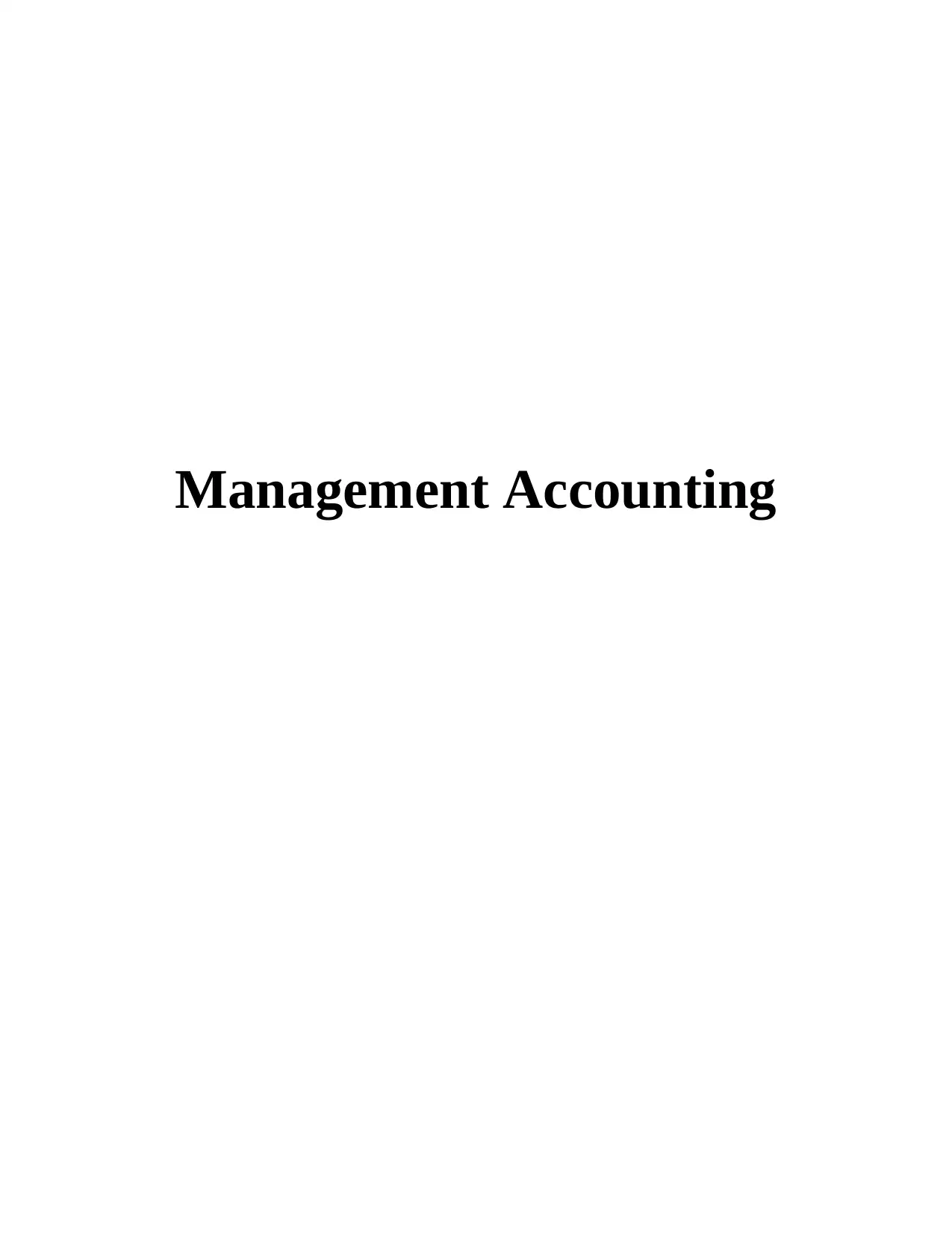
Management Accounting
Paraphrase This Document
Need a fresh take? Get an instant paraphrase of this document with our AI Paraphraser
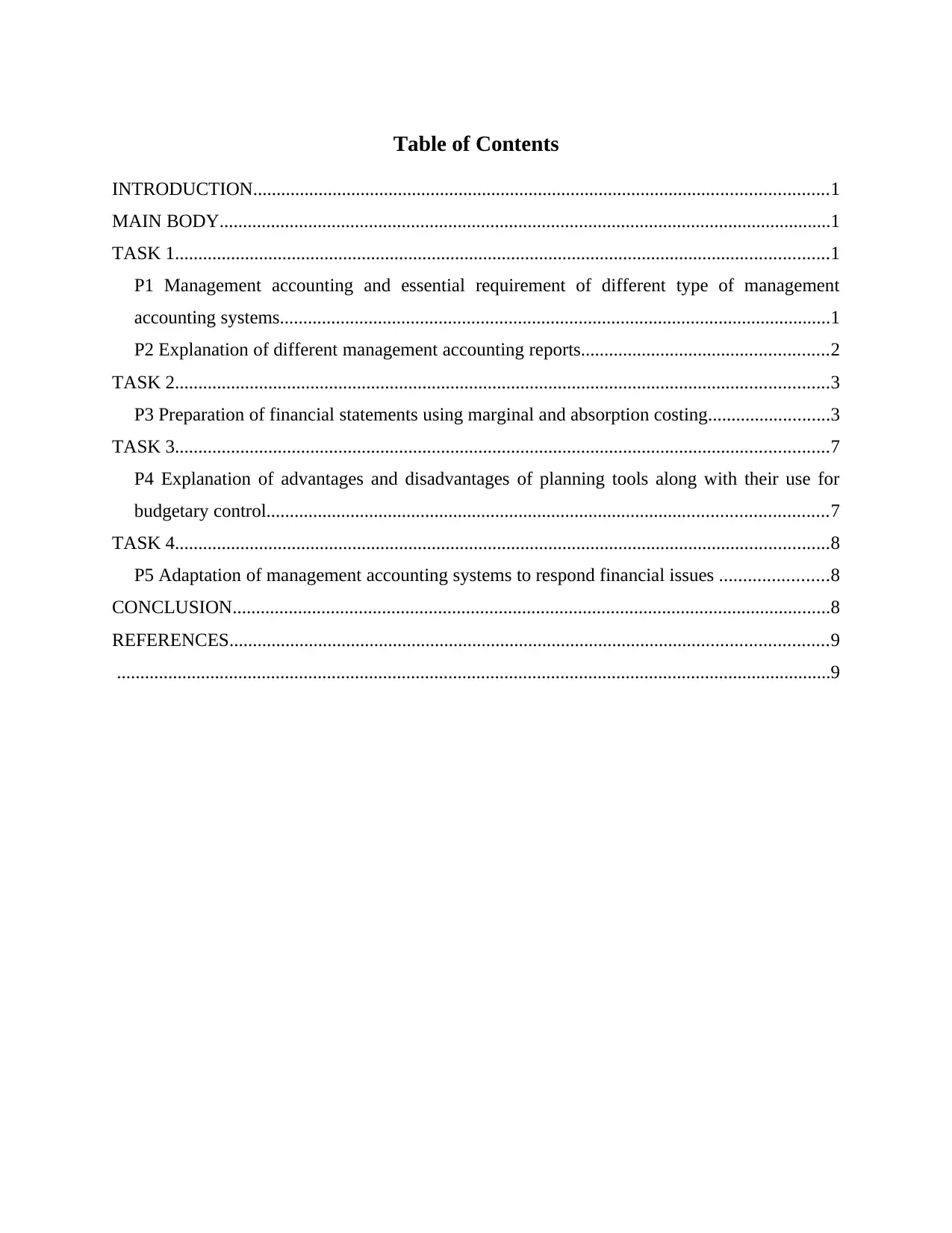
Table of Contents
INTRODUCTION...........................................................................................................................1
MAIN BODY...................................................................................................................................1
TASK 1............................................................................................................................................1
P1 Management accounting and essential requirement of different type of management
accounting systems......................................................................................................................1
P2 Explanation of different management accounting reports.....................................................2
TASK 2............................................................................................................................................3
P3 Preparation of financial statements using marginal and absorption costing..........................3
TASK 3............................................................................................................................................7
P4 Explanation of advantages and disadvantages of planning tools along with their use for
budgetary control........................................................................................................................7
TASK 4............................................................................................................................................8
P5 Adaptation of management accounting systems to respond financial issues .......................8
CONCLUSION................................................................................................................................8
REFERENCES................................................................................................................................9
.........................................................................................................................................................9
INTRODUCTION...........................................................................................................................1
MAIN BODY...................................................................................................................................1
TASK 1............................................................................................................................................1
P1 Management accounting and essential requirement of different type of management
accounting systems......................................................................................................................1
P2 Explanation of different management accounting reports.....................................................2
TASK 2............................................................................................................................................3
P3 Preparation of financial statements using marginal and absorption costing..........................3
TASK 3............................................................................................................................................7
P4 Explanation of advantages and disadvantages of planning tools along with their use for
budgetary control........................................................................................................................7
TASK 4............................................................................................................................................8
P5 Adaptation of management accounting systems to respond financial issues .......................8
CONCLUSION................................................................................................................................8
REFERENCES................................................................................................................................9
.........................................................................................................................................................9

⊘ This is a preview!⊘
Do you want full access?
Subscribe today to unlock all pages.

Trusted by 1+ million students worldwide

INTRODUCTION
Management accounting refers as an effective practice used by an organisation to
identifying, measuring, analysing and interpreting financial information to business managers. In
addition, it is a field of accounting that gives financial and economic information for managers as
well as to other internal users. The application of different methods of management accounting
has their own various benefits which are attained by an organisation. This will provides an
opportunity to bring consistency in business operations through ascertainment of coordination in
between the internal department workings. The organisation which is considered for completion
is named as AstraZeneca. This organisation has their operations in manufacturing sector. The
main aim of this report is about determination of benefits associated with the use of management
accounting methods (Abdullahj and et.al, 2015).
The aspects which are covers in the report includes information about different type of
management accounting systems along with their benefits and various management accounting
reports. Also, covers about preparation of income statement by the use of marginal and
absorption costing methods, use of planning tools for budgetary control and adaptation of
management accounting systems to respond financial problems.
MAIN BODY
TASK 1
P1 Management accounting and essential requirement of different type of management
accounting systems
Management Accounting
This includes the use of accounting methods and techniques that help to ascertain
financial information regarding operations of an organisation. This will be further used by the
management of an organisation to build decisions and frame strategies to attain growth
(Management Accounting. 2018).
Management Accounting systems
The different kind of methods persists under this includes cost accounting, inventory
management, price optimisation etc. All these have their own different working from the
organisation perspective. Further, this will provide information which is use by internal
management to made department functioning more profound in overall nature. AstraZeneca is
1
Management accounting refers as an effective practice used by an organisation to
identifying, measuring, analysing and interpreting financial information to business managers. In
addition, it is a field of accounting that gives financial and economic information for managers as
well as to other internal users. The application of different methods of management accounting
has their own various benefits which are attained by an organisation. This will provides an
opportunity to bring consistency in business operations through ascertainment of coordination in
between the internal department workings. The organisation which is considered for completion
is named as AstraZeneca. This organisation has their operations in manufacturing sector. The
main aim of this report is about determination of benefits associated with the use of management
accounting methods (Abdullahj and et.al, 2015).
The aspects which are covers in the report includes information about different type of
management accounting systems along with their benefits and various management accounting
reports. Also, covers about preparation of income statement by the use of marginal and
absorption costing methods, use of planning tools for budgetary control and adaptation of
management accounting systems to respond financial problems.
MAIN BODY
TASK 1
P1 Management accounting and essential requirement of different type of management
accounting systems
Management Accounting
This includes the use of accounting methods and techniques that help to ascertain
financial information regarding operations of an organisation. This will be further used by the
management of an organisation to build decisions and frame strategies to attain growth
(Management Accounting. 2018).
Management Accounting systems
The different kind of methods persists under this includes cost accounting, inventory
management, price optimisation etc. All these have their own different working from the
organisation perspective. Further, this will provide information which is use by internal
management to made department functioning more profound in overall nature. AstraZeneca is
1
Paraphrase This Document
Need a fresh take? Get an instant paraphrase of this document with our AI Paraphraser
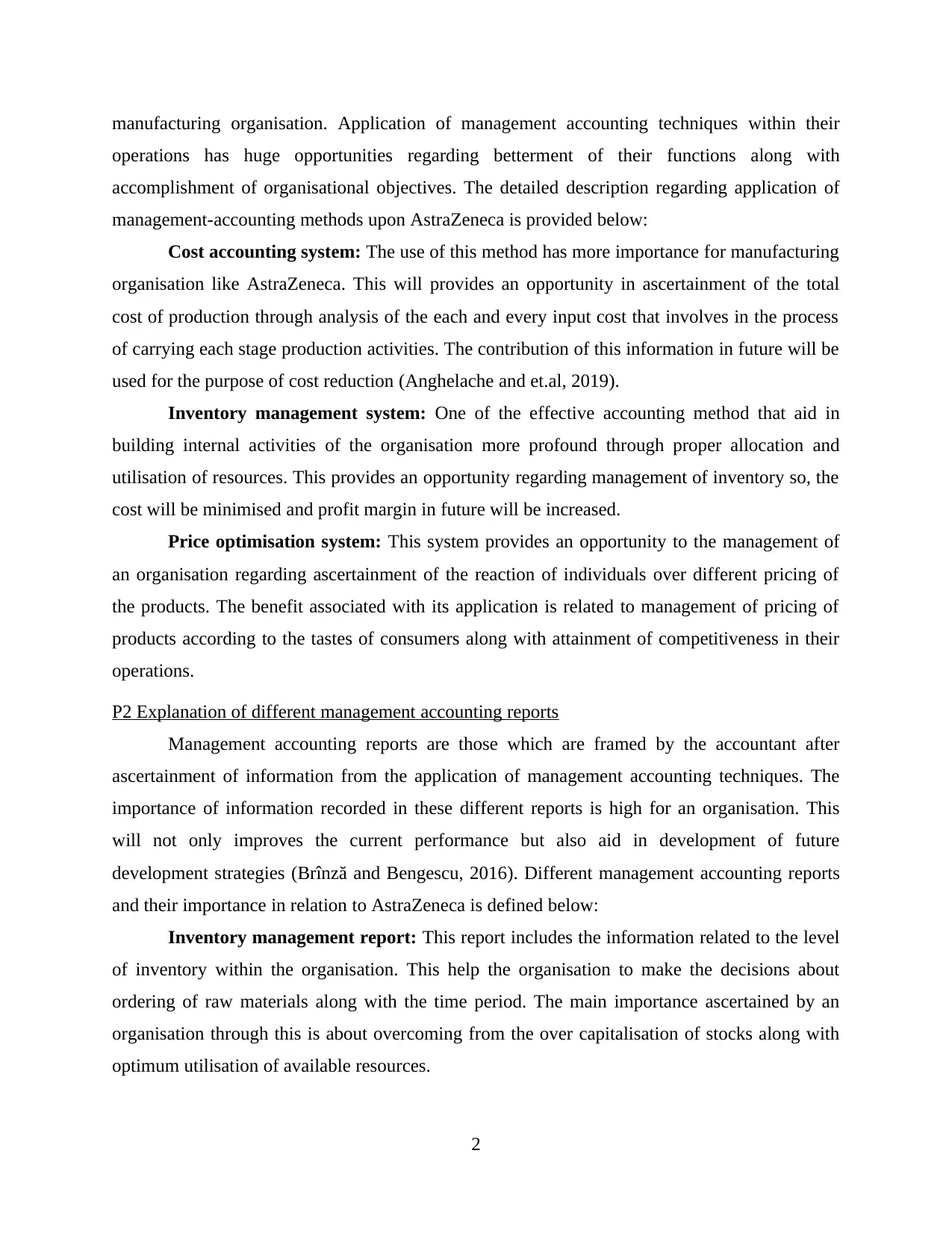
manufacturing organisation. Application of management accounting techniques within their
operations has huge opportunities regarding betterment of their functions along with
accomplishment of organisational objectives. The detailed description regarding application of
management-accounting methods upon AstraZeneca is provided below:
Cost accounting system: The use of this method has more importance for manufacturing
organisation like AstraZeneca. This will provides an opportunity in ascertainment of the total
cost of production through analysis of the each and every input cost that involves in the process
of carrying each stage production activities. The contribution of this information in future will be
used for the purpose of cost reduction (Anghelache and et.al, 2019).
Inventory management system: One of the effective accounting method that aid in
building internal activities of the organisation more profound through proper allocation and
utilisation of resources. This provides an opportunity regarding management of inventory so, the
cost will be minimised and profit margin in future will be increased.
Price optimisation system: This system provides an opportunity to the management of
an organisation regarding ascertainment of the reaction of individuals over different pricing of
the products. The benefit associated with its application is related to management of pricing of
products according to the tastes of consumers along with attainment of competitiveness in their
operations.
P2 Explanation of different management accounting reports
Management accounting reports are those which are framed by the accountant after
ascertainment of information from the application of management accounting techniques. The
importance of information recorded in these different reports is high for an organisation. This
will not only improves the current performance but also aid in development of future
development strategies (Brînză and Bengescu, 2016). Different management accounting reports
and their importance in relation to AstraZeneca is defined below:
Inventory management report: This report includes the information related to the level
of inventory within the organisation. This help the organisation to make the decisions about
ordering of raw materials along with the time period. The main importance ascertained by an
organisation through this is about overcoming from the over capitalisation of stocks along with
optimum utilisation of available resources.
2
operations has huge opportunities regarding betterment of their functions along with
accomplishment of organisational objectives. The detailed description regarding application of
management-accounting methods upon AstraZeneca is provided below:
Cost accounting system: The use of this method has more importance for manufacturing
organisation like AstraZeneca. This will provides an opportunity in ascertainment of the total
cost of production through analysis of the each and every input cost that involves in the process
of carrying each stage production activities. The contribution of this information in future will be
used for the purpose of cost reduction (Anghelache and et.al, 2019).
Inventory management system: One of the effective accounting method that aid in
building internal activities of the organisation more profound through proper allocation and
utilisation of resources. This provides an opportunity regarding management of inventory so, the
cost will be minimised and profit margin in future will be increased.
Price optimisation system: This system provides an opportunity to the management of
an organisation regarding ascertainment of the reaction of individuals over different pricing of
the products. The benefit associated with its application is related to management of pricing of
products according to the tastes of consumers along with attainment of competitiveness in their
operations.
P2 Explanation of different management accounting reports
Management accounting reports are those which are framed by the accountant after
ascertainment of information from the application of management accounting techniques. The
importance of information recorded in these different reports is high for an organisation. This
will not only improves the current performance but also aid in development of future
development strategies (Brînză and Bengescu, 2016). Different management accounting reports
and their importance in relation to AstraZeneca is defined below:
Inventory management report: This report includes the information related to the level
of inventory within the organisation. This help the organisation to make the decisions about
ordering of raw materials along with the time period. The main importance ascertained by an
organisation through this is about overcoming from the over capitalisation of stocks along with
optimum utilisation of available resources.
2
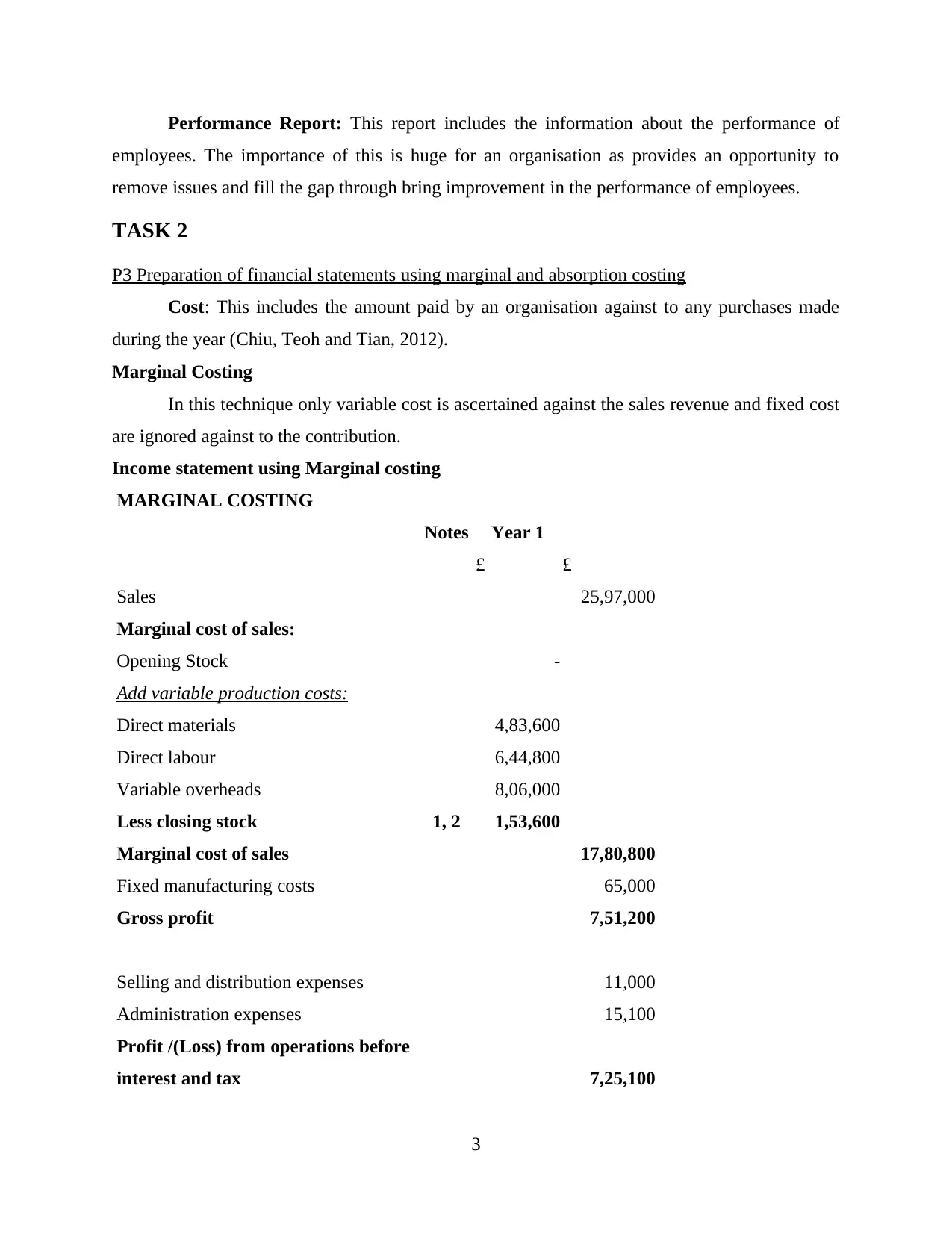
Performance Report: This report includes the information about the performance of
employees. The importance of this is huge for an organisation as provides an opportunity to
remove issues and fill the gap through bring improvement in the performance of employees.
TASK 2
P3 Preparation of financial statements using marginal and absorption costing
Cost: This includes the amount paid by an organisation against to any purchases made
during the year (Chiu, Teoh and Tian, 2012).
Marginal Costing
In this technique only variable cost is ascertained against the sales revenue and fixed cost
are ignored against to the contribution.
Income statement using Marginal costing
MARGINAL COSTING
Notes Year 1
£ £
Sales 25,97,000
Marginal cost of sales:
Opening Stock -
Add variable production costs:
Direct materials 4,83,600
Direct labour 6,44,800
Variable overheads 8,06,000
Less closing stock 1, 2 1,53,600
Marginal cost of sales 17,80,800
Fixed manufacturing costs 65,000
Gross profit 7,51,200
Selling and distribution expenses 11,000
Administration expenses 15,100
Profit /(Loss) from operations before
interest and tax 7,25,100
3
employees. The importance of this is huge for an organisation as provides an opportunity to
remove issues and fill the gap through bring improvement in the performance of employees.
TASK 2
P3 Preparation of financial statements using marginal and absorption costing
Cost: This includes the amount paid by an organisation against to any purchases made
during the year (Chiu, Teoh and Tian, 2012).
Marginal Costing
In this technique only variable cost is ascertained against the sales revenue and fixed cost
are ignored against to the contribution.
Income statement using Marginal costing
MARGINAL COSTING
Notes Year 1
£ £
Sales 25,97,000
Marginal cost of sales:
Opening Stock -
Add variable production costs:
Direct materials 4,83,600
Direct labour 6,44,800
Variable overheads 8,06,000
Less closing stock 1, 2 1,53,600
Marginal cost of sales 17,80,800
Fixed manufacturing costs 65,000
Gross profit 7,51,200
Selling and distribution expenses 11,000
Administration expenses 15,100
Profit /(Loss) from operations before
interest and tax 7,25,100
3
⊘ This is a preview!⊘
Do you want full access?
Subscribe today to unlock all pages.

Trusted by 1+ million students worldwide
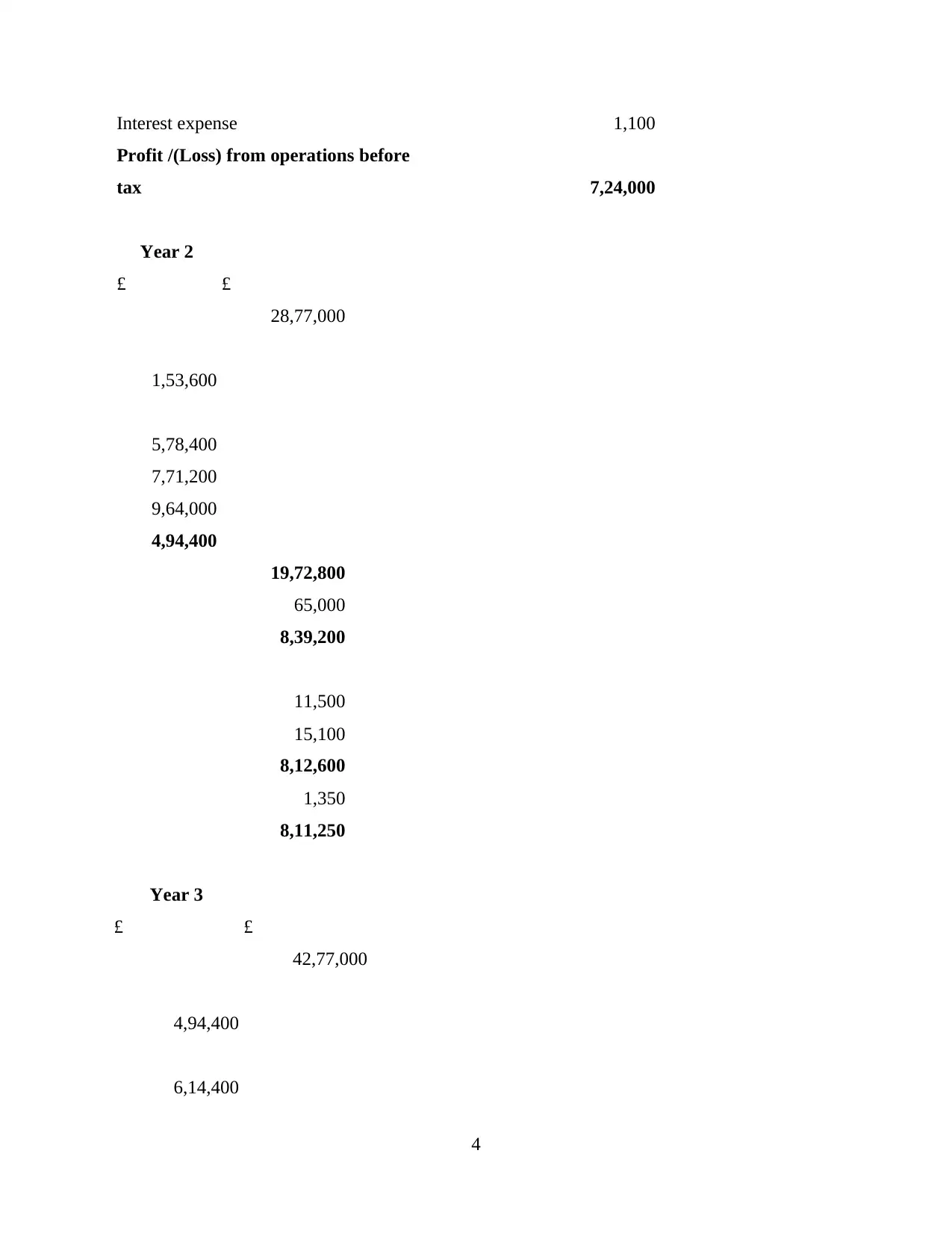
Interest expense 1,100
Profit /(Loss) from operations before
tax 7,24,000
Year 2
£ £
28,77,000
1,53,600
5,78,400
7,71,200
9,64,000
4,94,400
19,72,800
65,000
8,39,200
11,500
15,100
8,12,600
1,350
8,11,250
Year 3
£ £
42,77,000
4,94,400
6,14,400
4
Profit /(Loss) from operations before
tax 7,24,000
Year 2
£ £
28,77,000
1,53,600
5,78,400
7,71,200
9,64,000
4,94,400
19,72,800
65,000
8,39,200
11,500
15,100
8,12,600
1,350
8,11,250
Year 3
£ £
42,77,000
4,94,400
6,14,400
4
Paraphrase This Document
Need a fresh take? Get an instant paraphrase of this document with our AI Paraphraser
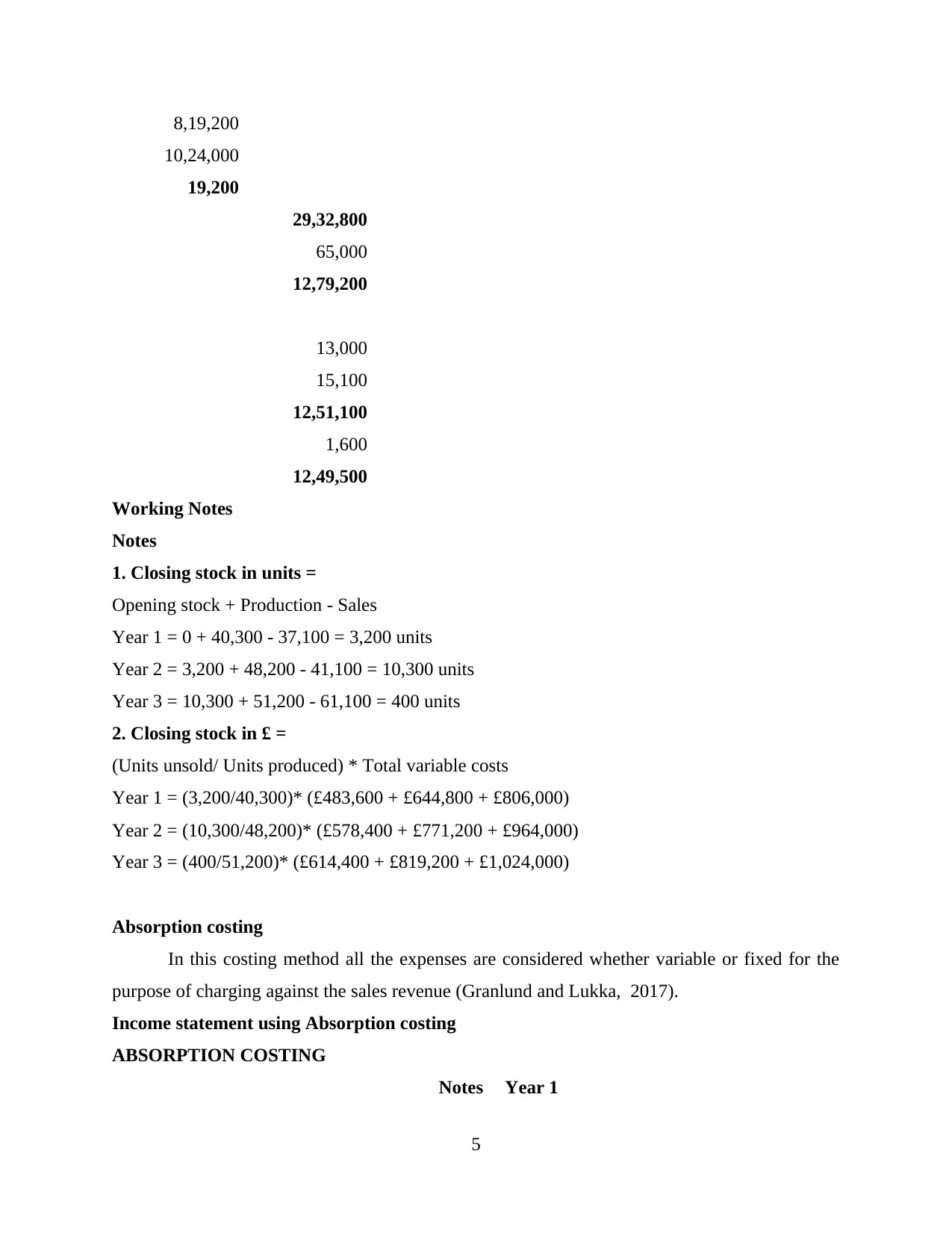
8,19,200
10,24,000
19,200
29,32,800
65,000
12,79,200
13,000
15,100
12,51,100
1,600
12,49,500
Working Notes
Notes
1. Closing stock in units =
Opening stock + Production - Sales
Year 1 = 0 + 40,300 - 37,100 = 3,200 units
Year 2 = 3,200 + 48,200 - 41,100 = 10,300 units
Year 3 = 10,300 + 51,200 - 61,100 = 400 units
2. Closing stock in £ =
(Units unsold/ Units produced) * Total variable costs
Year 1 = (3,200/40,300)* (£483,600 + £644,800 + £806,000)
Year 2 = (10,300/48,200)* (£578,400 + £771,200 + £964,000)
Year 3 = (400/51,200)* (£614,400 + £819,200 + £1,024,000)
Absorption costing
In this costing method all the expenses are considered whether variable or fixed for the
purpose of charging against the sales revenue (Granlund and Lukka, 2017).
Income statement using Absorption costing
ABSORPTION COSTING
Notes Year 1
5
10,24,000
19,200
29,32,800
65,000
12,79,200
13,000
15,100
12,51,100
1,600
12,49,500
Working Notes
Notes
1. Closing stock in units =
Opening stock + Production - Sales
Year 1 = 0 + 40,300 - 37,100 = 3,200 units
Year 2 = 3,200 + 48,200 - 41,100 = 10,300 units
Year 3 = 10,300 + 51,200 - 61,100 = 400 units
2. Closing stock in £ =
(Units unsold/ Units produced) * Total variable costs
Year 1 = (3,200/40,300)* (£483,600 + £644,800 + £806,000)
Year 2 = (10,300/48,200)* (£578,400 + £771,200 + £964,000)
Year 3 = (400/51,200)* (£614,400 + £819,200 + £1,024,000)
Absorption costing
In this costing method all the expenses are considered whether variable or fixed for the
purpose of charging against the sales revenue (Granlund and Lukka, 2017).
Income statement using Absorption costing
ABSORPTION COSTING
Notes Year 1
5
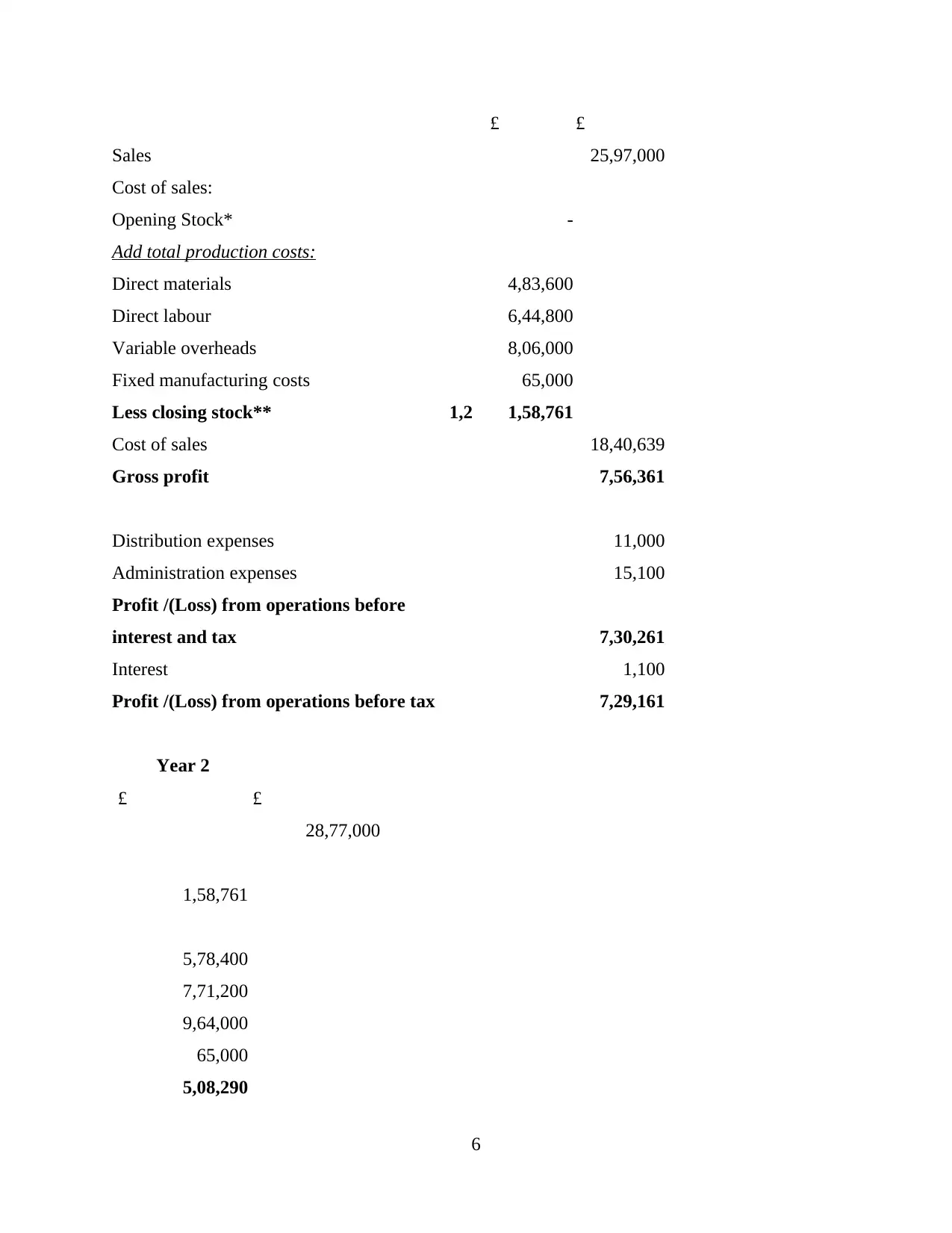
£ £
Sales 25,97,000
Cost of sales:
Opening Stock* -
Add total production costs:
Direct materials 4,83,600
Direct labour 6,44,800
Variable overheads 8,06,000
Fixed manufacturing costs 65,000
Less closing stock** 1,2 1,58,761
Cost of sales 18,40,639
Gross profit 7,56,361
Distribution expenses 11,000
Administration expenses 15,100
Profit /(Loss) from operations before
interest and tax 7,30,261
Interest 1,100
Profit /(Loss) from operations before tax 7,29,161
Year 2
£ £
28,77,000
1,58,761
5,78,400
7,71,200
9,64,000
65,000
5,08,290
6
Sales 25,97,000
Cost of sales:
Opening Stock* -
Add total production costs:
Direct materials 4,83,600
Direct labour 6,44,800
Variable overheads 8,06,000
Fixed manufacturing costs 65,000
Less closing stock** 1,2 1,58,761
Cost of sales 18,40,639
Gross profit 7,56,361
Distribution expenses 11,000
Administration expenses 15,100
Profit /(Loss) from operations before
interest and tax 7,30,261
Interest 1,100
Profit /(Loss) from operations before tax 7,29,161
Year 2
£ £
28,77,000
1,58,761
5,78,400
7,71,200
9,64,000
65,000
5,08,290
6
⊘ This is a preview!⊘
Do you want full access?
Subscribe today to unlock all pages.

Trusted by 1+ million students worldwide
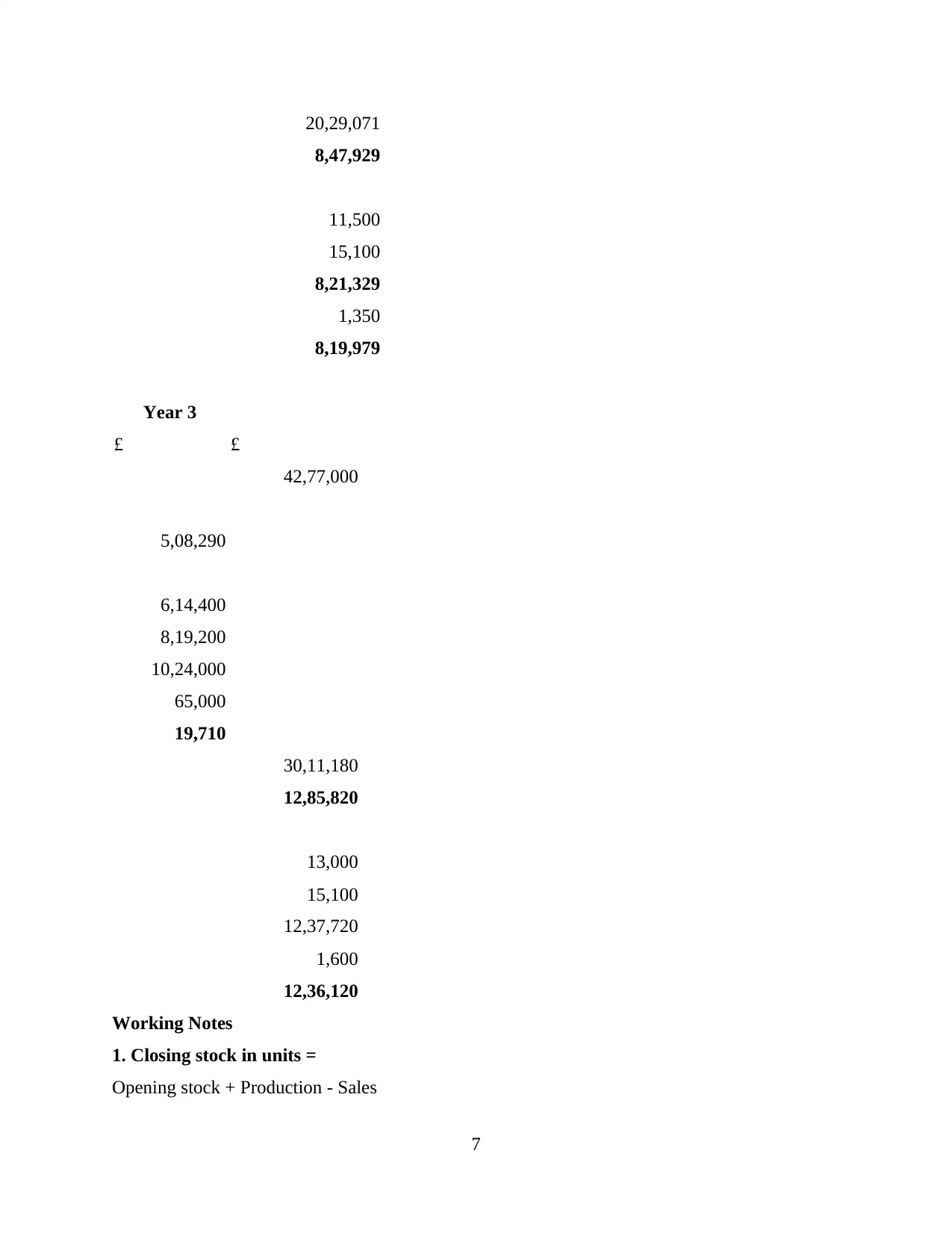
20,29,071
8,47,929
11,500
15,100
8,21,329
1,350
8,19,979
Year 3
£ £
42,77,000
5,08,290
6,14,400
8,19,200
10,24,000
65,000
19,710
30,11,180
12,85,820
13,000
15,100
12,37,720
1,600
12,36,120
Working Notes
1. Closing stock in units =
Opening stock + Production - Sales
7
8,47,929
11,500
15,100
8,21,329
1,350
8,19,979
Year 3
£ £
42,77,000
5,08,290
6,14,400
8,19,200
10,24,000
65,000
19,710
30,11,180
12,85,820
13,000
15,100
12,37,720
1,600
12,36,120
Working Notes
1. Closing stock in units =
Opening stock + Production - Sales
7
Paraphrase This Document
Need a fresh take? Get an instant paraphrase of this document with our AI Paraphraser
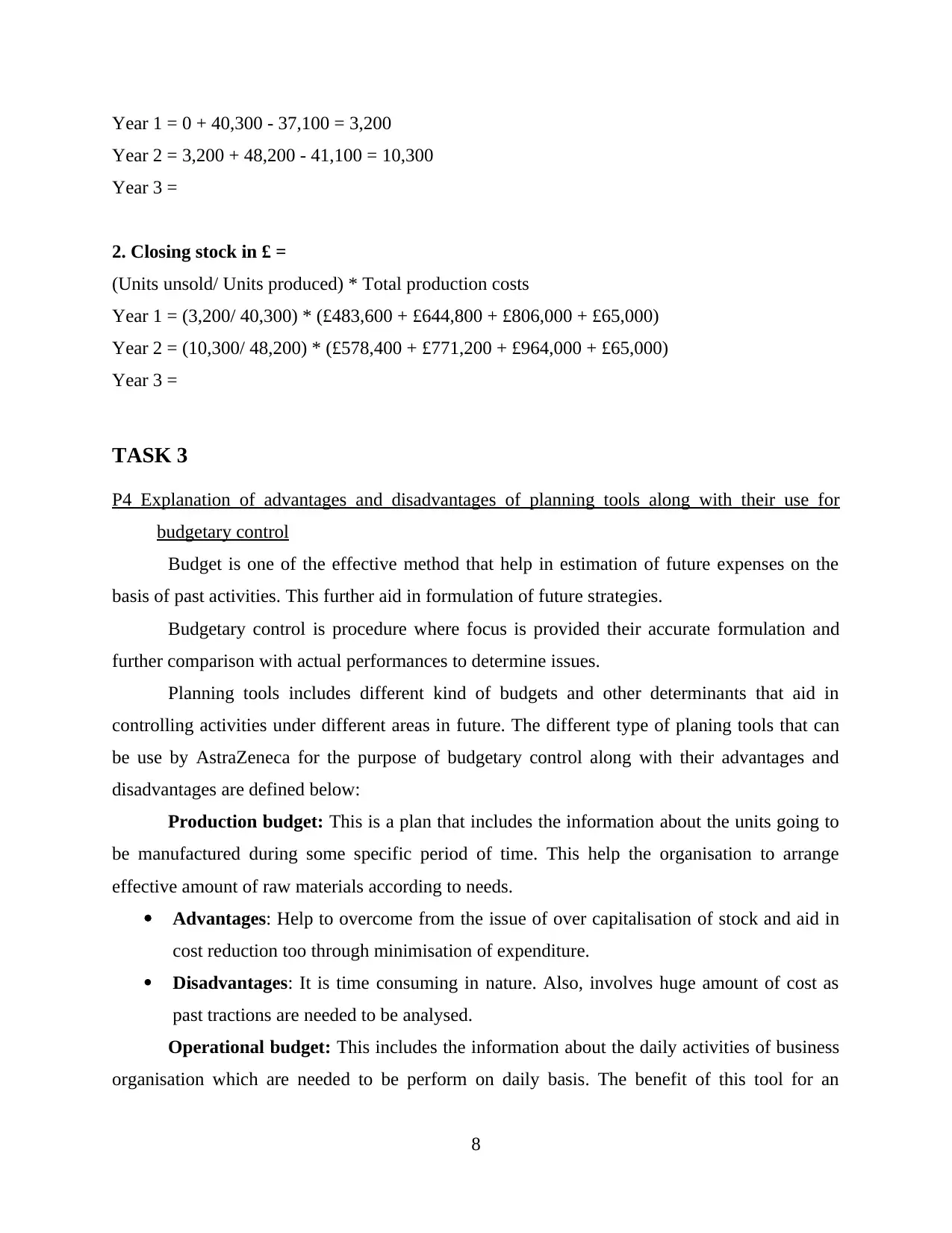
Year 1 = 0 + 40,300 - 37,100 = 3,200
Year 2 = 3,200 + 48,200 - 41,100 = 10,300
Year 3 =
2. Closing stock in £ =
(Units unsold/ Units produced) * Total production costs
Year 1 = (3,200/ 40,300) * (£483,600 + £644,800 + £806,000 + £65,000)
Year 2 = (10,300/ 48,200) * (£578,400 + £771,200 + £964,000 + £65,000)
Year 3 =
TASK 3
P4 Explanation of advantages and disadvantages of planning tools along with their use for
budgetary control
Budget is one of the effective method that help in estimation of future expenses on the
basis of past activities. This further aid in formulation of future strategies.
Budgetary control is procedure where focus is provided their accurate formulation and
further comparison with actual performances to determine issues.
Planning tools includes different kind of budgets and other determinants that aid in
controlling activities under different areas in future. The different type of planing tools that can
be use by AstraZeneca for the purpose of budgetary control along with their advantages and
disadvantages are defined below:
Production budget: This is a plan that includes the information about the units going to
be manufactured during some specific period of time. This help the organisation to arrange
effective amount of raw materials according to needs.
Advantages: Help to overcome from the issue of over capitalisation of stock and aid in
cost reduction too through minimisation of expenditure.
Disadvantages: It is time consuming in nature. Also, involves huge amount of cost as
past tractions are needed to be analysed.
Operational budget: This includes the information about the daily activities of business
organisation which are needed to be perform on daily basis. The benefit of this tool for an
8
Year 2 = 3,200 + 48,200 - 41,100 = 10,300
Year 3 =
2. Closing stock in £ =
(Units unsold/ Units produced) * Total production costs
Year 1 = (3,200/ 40,300) * (£483,600 + £644,800 + £806,000 + £65,000)
Year 2 = (10,300/ 48,200) * (£578,400 + £771,200 + £964,000 + £65,000)
Year 3 =
TASK 3
P4 Explanation of advantages and disadvantages of planning tools along with their use for
budgetary control
Budget is one of the effective method that help in estimation of future expenses on the
basis of past activities. This further aid in formulation of future strategies.
Budgetary control is procedure where focus is provided their accurate formulation and
further comparison with actual performances to determine issues.
Planning tools includes different kind of budgets and other determinants that aid in
controlling activities under different areas in future. The different type of planing tools that can
be use by AstraZeneca for the purpose of budgetary control along with their advantages and
disadvantages are defined below:
Production budget: This is a plan that includes the information about the units going to
be manufactured during some specific period of time. This help the organisation to arrange
effective amount of raw materials according to needs.
Advantages: Help to overcome from the issue of over capitalisation of stock and aid in
cost reduction too through minimisation of expenditure.
Disadvantages: It is time consuming in nature. Also, involves huge amount of cost as
past tractions are needed to be analysed.
Operational budget: This includes the information about the daily activities of business
organisation which are needed to be perform on daily basis. The benefit of this tool for an
8
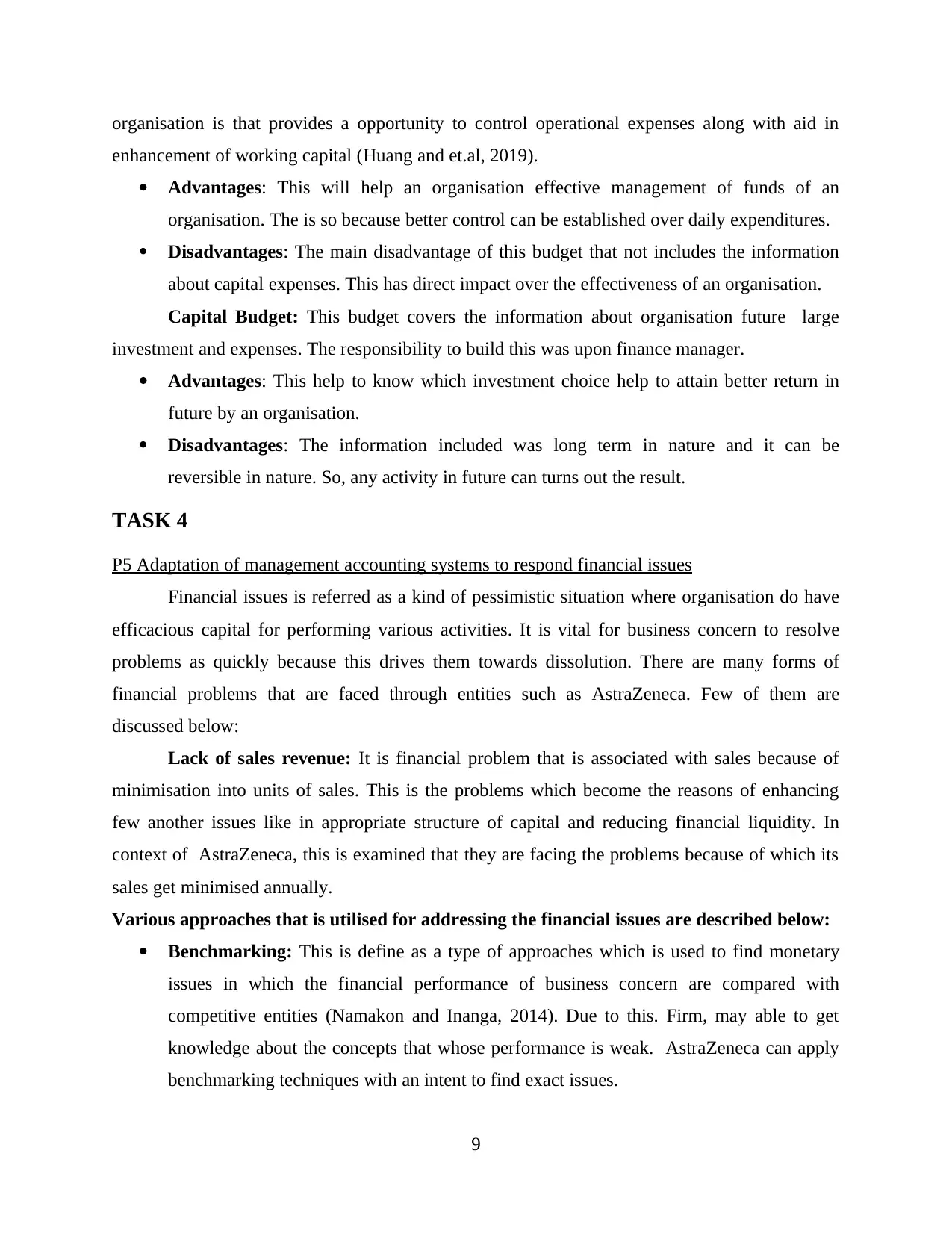
organisation is that provides a opportunity to control operational expenses along with aid in
enhancement of working capital (Huang and et.al, 2019).
Advantages: This will help an organisation effective management of funds of an
organisation. The is so because better control can be established over daily expenditures.
Disadvantages: The main disadvantage of this budget that not includes the information
about capital expenses. This has direct impact over the effectiveness of an organisation.
Capital Budget: This budget covers the information about organisation future large
investment and expenses. The responsibility to build this was upon finance manager.
Advantages: This help to know which investment choice help to attain better return in
future by an organisation.
Disadvantages: The information included was long term in nature and it can be
reversible in nature. So, any activity in future can turns out the result.
TASK 4
P5 Adaptation of management accounting systems to respond financial issues
Financial issues is referred as a kind of pessimistic situation where organisation do have
efficacious capital for performing various activities. It is vital for business concern to resolve
problems as quickly because this drives them towards dissolution. There are many forms of
financial problems that are faced through entities such as AstraZeneca. Few of them are
discussed below:
Lack of sales revenue: It is financial problem that is associated with sales because of
minimisation into units of sales. This is the problems which become the reasons of enhancing
few another issues like in appropriate structure of capital and reducing financial liquidity. In
context of AstraZeneca, this is examined that they are facing the problems because of which its
sales get minimised annually.
Various approaches that is utilised for addressing the financial issues are described below:
Benchmarking: This is define as a type of approaches which is used to find monetary
issues in which the financial performance of business concern are compared with
competitive entities (Namakon and Inanga, 2014). Due to this. Firm, may able to get
knowledge about the concepts that whose performance is weak. AstraZeneca can apply
benchmarking techniques with an intent to find exact issues.
9
enhancement of working capital (Huang and et.al, 2019).
Advantages: This will help an organisation effective management of funds of an
organisation. The is so because better control can be established over daily expenditures.
Disadvantages: The main disadvantage of this budget that not includes the information
about capital expenses. This has direct impact over the effectiveness of an organisation.
Capital Budget: This budget covers the information about organisation future large
investment and expenses. The responsibility to build this was upon finance manager.
Advantages: This help to know which investment choice help to attain better return in
future by an organisation.
Disadvantages: The information included was long term in nature and it can be
reversible in nature. So, any activity in future can turns out the result.
TASK 4
P5 Adaptation of management accounting systems to respond financial issues
Financial issues is referred as a kind of pessimistic situation where organisation do have
efficacious capital for performing various activities. It is vital for business concern to resolve
problems as quickly because this drives them towards dissolution. There are many forms of
financial problems that are faced through entities such as AstraZeneca. Few of them are
discussed below:
Lack of sales revenue: It is financial problem that is associated with sales because of
minimisation into units of sales. This is the problems which become the reasons of enhancing
few another issues like in appropriate structure of capital and reducing financial liquidity. In
context of AstraZeneca, this is examined that they are facing the problems because of which its
sales get minimised annually.
Various approaches that is utilised for addressing the financial issues are described below:
Benchmarking: This is define as a type of approaches which is used to find monetary
issues in which the financial performance of business concern are compared with
competitive entities (Namakon and Inanga, 2014). Due to this. Firm, may able to get
knowledge about the concepts that whose performance is weak. AstraZeneca can apply
benchmarking techniques with an intent to find exact issues.
9
⊘ This is a preview!⊘
Do you want full access?
Subscribe today to unlock all pages.

Trusted by 1+ million students worldwide
1 out of 15
Related Documents
Your All-in-One AI-Powered Toolkit for Academic Success.
+13062052269
info@desklib.com
Available 24*7 on WhatsApp / Email
![[object Object]](/_next/static/media/star-bottom.7253800d.svg)
Unlock your academic potential
Copyright © 2020–2025 A2Z Services. All Rights Reserved. Developed and managed by ZUCOL.





